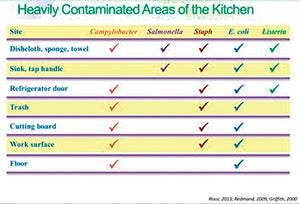Avoid illness; keep your kitchen area clean
Published 5:15 pm Saturday, September 28, 2013
One out of every six Americans is sickened by food poisoning each year, and who is the most vulnerable? Preschool children, pregnant women and older adults. Many of those cases arise from our home kitchens. Take this quiz to determine how safe your kitchen is:
True/False: Hands should be rinsed in water for at least five seconds before preparing foods and after handling raw meats.
 False: It is estimated that proper hand washing for 20 seconds could eliminate up to half of all foodborne illnesses. At home, wash your hands often with warm and soapy water, especially before and after handling raw meat and eggs, as well as prepared food. It’s not enough to just rinse with water alone.
False: It is estimated that proper hand washing for 20 seconds could eliminate up to half of all foodborne illnesses. At home, wash your hands often with warm and soapy water, especially before and after handling raw meat and eggs, as well as prepared food. It’s not enough to just rinse with water alone.
True/False: One way to prevent cross-contamination is to use two cutting boards, one strictly for raw meats, poultry and seafood and another for ready-to-eat foods.
True: Using two different cutting boards reduces your risk of cross-contamination preventing the spread of harmful bacteria.
True/False: After cutting meat on a cutting board, the best way to clean a cutting board is to rinse it in hot water.
False: First, clean thoroughly with hot, soapy water. Next, rinse the board with clean water and finally, sanitize the board with a chlorine bleach solution. To make your own bleach solution, dilute one tablespoon of bleach in one gallon of water.
True/False: A food thermometer is the only reliable way to check the doneness of meats, poultry, egg dishes and leftovers.
True: Harmful bacteria are destroyed when food is cooked to a proper temperature; and the only way to know that is to use a food thermometer. Find a food temp guide: http://homefoodsafety.org/safety-tips/cook.
True/False: Meat, fish and poultry should be defrosted on the counter.
False: Meat, fish and poultry should only be defrosted in the refrigerator or in the microwave. When defrosting in the refrigerator, place raw meat on the lowest shelf so it won’t drip onto other prepared foods. When defrosting in the microwave, use the meat immediately in cooking.
How to make your kitchen safer?
•Wash: Bacteria can survive in many places including hands, utensils and cutting boards. Proper hand washing can eliminate half of all cases of foodborne illness. Don’t forget about frequently washing dish cloths and any surfaces with hot, soapy water. Disinfect sponges with bleach.
•Separate: Don’t cross-contaminate. It starts in your shopping cart with raw foods and ends in the kitchen. Use clean reusable grocery bags (only 3 percent of Americans wash their grocery bags) and separate cutting boards, and store food properly in the refrigerator.
•Cook: You can’t rely on color and texture to know if a food is safe to eat. You must use a food thermometer. Place the thermometer in the thickest part of the food (not touching bone or gristle) and compare the temperature to a food temperature chart. Wash thermometer with hot, soapy water after use.
•Refrigerate: Cool foods quickly to prevent food poisoning. Leftover foods should not stay out of refrigeration longer than two hours (and in cases more than 90 degrees, one hour). Make sure your refrigerator is set below 40 degrees.
With these tips, you can reduce your chances of foodborne illness for yourself and your family. Visit www.homefoodsafety.org for more information.


